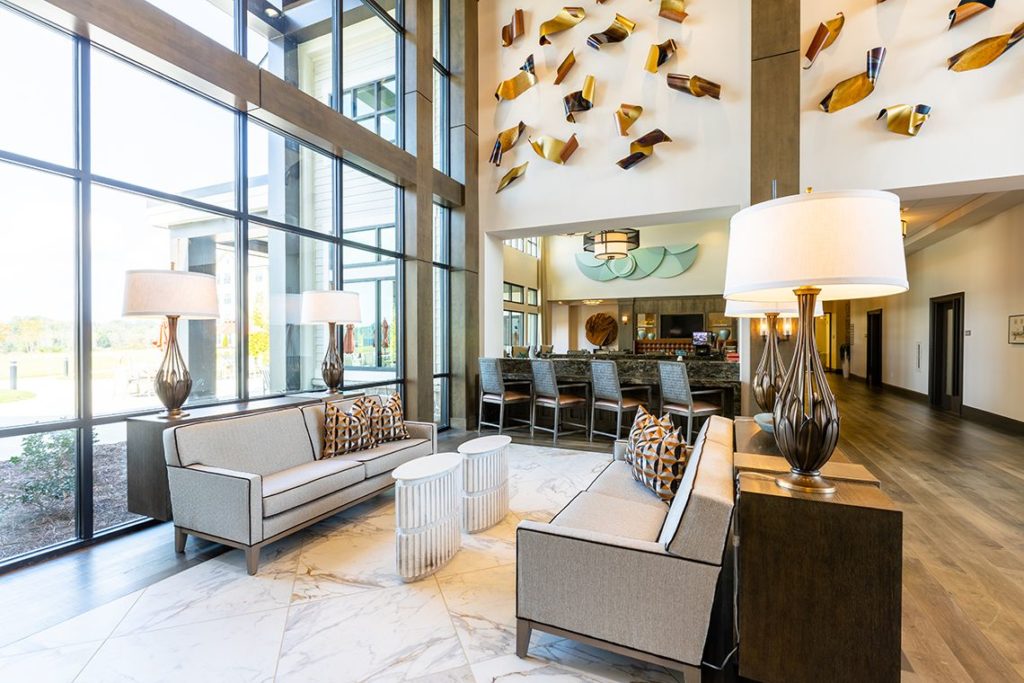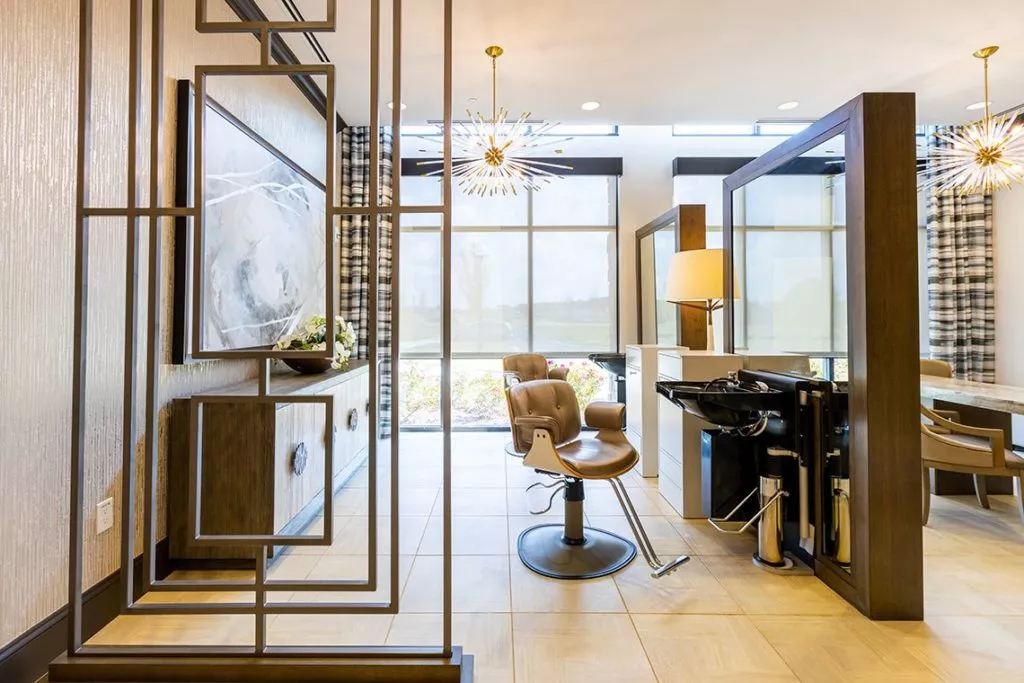The Spires at Berry College has a claim to fame, being located on the world’s largest college campus. And the recently opened continuing care retirement community (CCRC) makes the most of its location by integrating seamlessly with its picturesque surroundings and the neighboring school.
Laurie Steber could tell that the community was going to be special even before it was complete. She was working in senior living in North Carolina when she saw the job listing for the executive director position.
“When I saw this job posted, the stars aligned and the sky opened up — it was almost a physical reaction,” she told Senior Housing News.
Some of her excitement was due to personal connections. She grew up in Atlanta, and her nephew attended Berry College, which is about an hour-and-a-half northwest of the Georgia capital, near the city of Rome. But Steber also was excited about the unique opportunity to create an intergenerational senior living community.
“What was so exciting was starting something from scratch — the student aspect makes it so different,” she said.
The architecture and design of The Spires at Berry College also are different than a typical life plan community, offering breathtaking views of a quarry lake and seamlessly integrating with the natural environment and the aesthetic of the college campus. The project was so successful in achieving its goals, it won top honors in the CCRC/Life Plan Community category of the 2020 Senior Housing News Architecture & Design Awards.
The concept
Being situated on 27,000 acres, Berry College has plenty of land, and the college also has a strong alumni base. So, creating a senior living community was an appealing prospect, and the college approached Dallas-based Greenbrier Development with the idea several years ago.
Considering the vast size of the Berry campus, there were several options for where to locate a CCRC, Greenbrier First Vice President Development Tony Teague told SHN. Ultimately, a site was chosen for two reasons: It would afford a breathtaking view of mountains and an old quarry lake — since named Eagle Lake — and it would be just one-third of a mile away from the student campus, affording easy access.
This site came with challenges, including the prevalence of the quarry rock. But Greenbrier and Berry College determined that the benefits would outweigh the costs and challenges.
Atlanta-based THW Design came on board as the architecture firm, and went through an iterative process with Greenbrier, Berry College and other project stakeholders to create the ultimate concept. Among the key considerations were creating a walkable community with access to the college campus and spaces for intergenerational programming, and harmonizing with the natural surroundings, THW President Jim Hudgins told SHN.
The architecture and design accomplish these goals in a variety of ways.
For instance, the design called for raising the grade of the building a few feet to maximize views down to the lake and out across the nearby mountains, Teague said. The building was also configured to maximize views of the water from common spaces and living units, with the inclusion of as many corner units as possible.

The prominent use of stone and glass helps connect the CCRC to its natural surroundings as well as Berry College, which features buildings that also use these materials. And — true to its name — The Spires at Berry College features several spires, which also are seen throughout the college campus.
The connection to nature and the aesthetic of Berry College carried over into the interior design.
“We were able to spend several days on campus and really get to see the beauty that is on their main campus and their mountain campus,” Stacy Peters, director of design at Faulkner Design Group, told SHN.
For the interiors, the Faulkner team developed a palette with warm neutral colors such as deep chocolates, warm grays and soft ivories, with “a bit more punch” coming from gold and bronze tones, teal and turquoise colors inspired by Eagle Lake, and deep wine and burgundy colors inspired by the fall foliage, said Nicole Hill, senior project manager at Faulkner.
The design firm also was given access to the archive of licensed Berry College photography, and framed images — both historical and present-day — are hung throughout the community.
The architect and interior designers both highlighted the independent living lobby as a striking example of all these design elements. The space features warm woods, a porcelain tile that emulates a Carrera marble, and stone with a split-face texture, all of which drive home the connection to nature. Yet, a homey feel is also created with furnishings such as high wingback chairs. The 30-foot ceilings add spaciousness and drama, and large windows afford views of the lake and mountains.
“I think that lobby is pretty special,” Hill said.
Although the Berry College campus is huge, keeping the CCRC’s footprint as compact as possible was a goal, to ensure walkability and keep project costs in check, Hudgins said. But the concept did evolve to include 26 freestanding cottages and a 17-unit independent living lodge, in addition to 144 independent living apartments and the assisted living and memory care building.
The lodge was added in response to shifting consumer preferences in the market, Hudgins said.
Spanning 400,000 square feet, the final design concept also includes a full complement of amenity spaces, such as a wellness center and salon, a saltwater swimming pool, formal and informal dining venues, and multiple lounges and common areas. The construction cost was about $81 million and the overall project budget was about $130 million.
“This is a large, well-conceived program and execution, and it builds on the story of its sponsor, partner, and neighbor, Berry College,” summed up SHN Awards judge David Dillard, principal and architect at HKS. In particular, Dillard singled out the “engagement with the lake” and the “simple, artful geometrics of the architecture” for praise.
The construction
Knowing that northwest Georgia can be rainy in the fall and winter, Greenbrier negotiated with the general contractor to get an early start on construction in October 2018. But, despite breaking ground early, rain fell on 40 of the first 100 days of construction.
“It was a big muddy mess,” said Steber, who arrived from North Carolina in November 2019. “… Then the pandemic hit, and we said, ‘I wish we were just complaining about the rain.’”
In response to Covid-19, the general contractor (GC) implemented a variety of precautions, including the use of wristbands to ensure that everyone on the site went through a wellness check. The pandemic created other obstacles, such as certain suppliers shutting down periodically.

Despite all these challenges, the opening was not significantly delayed. The first round of interior design installation took place in May 2020, with a second round in August.
“We had a really close working relationship with the developer and GC, so there was a lot of planning that went into making sure our team was safe during the install, and the GC handled it with the utmost professionalism,” Peters said.
The first residents arrived in June 2020, and the full campus opened in the fall.
“It was phenomenal to see the community take shape,” Steber said. “… Everyone put their heads down and carried on.”
The completion
Despite being in the midst of a pandemic, the opening of The Spires at Berry College has been successful, thanks in part to the intergenerational component of the project.
In May 2020, 14 Berry College students began working full-time at The Spires to help prepare the community for opening and welcome its first residents. Through the Gates Scholars program, these students put in a “serious” number of working hours each year, with their earnings going in part toward their tuition, Steber said.
The program is in keeping with the ethos of Berry College. The school was started by a woman named Martha Berry at the turn of the 20th Century, and many students came with little or no money and worked to pay for their education, including at the foundry that was located on campus at the time. Today, more than 90% of students at Berry hold down a job, Steber said.
“They’re trying so hard to bring them real-life experiences, and there’s not much more real life than senior living,” Steber said, adding that she could see a Berry College student one day rising to become the executive director of the community.
The student body at Berry College did have some initial reservations about having older adults as neighbors, but the CCRC and college are proving to have a mutually beneficial relationship.
“The residents are thrilled to death to be involved daily with all these great students, and the students are really loving the fact that they are getting to know the residents so well,” Steber said.
The pandemic has put a crimp in how many activities can occur, but intergenerational programming and interaction will increase as Covid-19 wanes. Residents at the CCRC will be able to simply walk the path over to the college to audit classes, attend theatrical productions and attend sporting events.
“We have football players here, we all know their numbers,” Steber said. “We can’t wait for games; we tell them that they’re going to be so embarrassed to have 200 people cheering for them on the sidelines.”
The connection to nature, in terms of the views and the options for outdoor activities like hiking, has also been a huge benefit during Covid-19, she said. Residents have remarked on what a spectacular location The Spires is to shelter in place.
“We were able to be here and grow a sense of community. We’ve been together, totally safe, socially distanced, masks up … we opened that way, so it doesn’t feel that odd to us,” Steber said.
Though lease-up is slower than would be expected under normal circumstances, more than 100 people have moved in since June, Teague noted. And he is proud that Greenbrier and the rest of the project team were able to bring something so ambitious and unique to the market.
“We all worked together very hard, a lot of long hours to get this community open,” he said. “Even before Covid, there was a great determination to make this the best project we could … it’s really one of a kind.”









